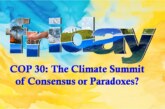Excerpts from an interview of Dr. Essam Yassin Mohammed, Senior Director of Aquatic Food Systems CGIAR & Director General, WorldFish by Dr. Arvind Kumar, Editor, Focus Global Reporter
Dr. Essam Yassin Mohammed, Senior Director of Aquatic Food Systems CGIAR & Director General of WorldFish, leads global research and innovation in aquatic food systems. With expertise in fisheries science and environmental economics, he integrates economic and conservation strategies to promote sustainable development. Renowned for influential publications and international advocacy, Dr. Mohammed drives WorldFish’s impact on food security, nutrition, and livelihoods through science, technology, and strategic partnerships. His visionary leadership focuses on long-term resilience for communities and aquatic ecosystems worldwide.
INTERVIEW
EDITOR: CGIAR is known for its focus on transforming food, land, and water systems. Could you elaborate on how CGIAR integrates environmental health and biodiversity into its research and innovation agenda, especially in the context of aquatic food systems?
DR. ESSAM Y. MOHAMMED: WorldFish has actually made environmental sustainability and climate resilience a core pillar of its 2030 research and innovation strategy. This means every program is designed with ecosystem sustainability in mind. In practice, we’re pursuing “nature-positive” solutions. For example, our WorldFish teams work on preserving aquatic biodiversity by protecting wild fish stocks and their habitats even as we promote aquaculture. We integrate fish genetic conservation into breeding programs and encourage polyculture (farming multiple species in one system) which mimics natural ecosystems. So when we develop new fish farming techniques or fisheries management plans, they are vetted for environmental co-benefits like maintaining water quality, conserving mangroves and wetlands, and safeguarding endangered species.
We also champion an ecosystem approach to fisheries: working with communities to establish no-fishing zones or sanctuaries so that depleted species can rebound. Overall, environmental stewardship is built into our innovation pipeline. We recognize that without healthy ecosystems and rich biodiversity, aquatic food systems can’t be sustainable in the long run. It’s about ensuring aquatic foods are produced in ways that restore nature rather than harm it. This philosophy guides everything from breeding resilient fish strains to advising governments on policies that balance production with conservation.
EDITOR: Which countries right now lead in global aquaculture production and what can be done to improve sustainable aquaculture in low-income countries or regions?
DR. ESSAM Y. MOHAMMED: Aquaculture has boomed worldwide, and a few countries dominate. China is by far the largest producer, accounting for over half of all farmed fish and seafood globally. After China, the biggest contributors include India, Indonesia, Vietnam, and Bangladesh, which each have robust aquaculture sectors. In fact, Asia produces nearly 90% of the world’s farmed fish. India, for instance, is now among the top aquaculture producers, with carp and shrimp farming contributing greatly to its output. These leading Asian producers drive the trends – their success has made Asia the epicenter of global aquaculture growth.
In contrast, many low-income regions, like parts of Africa, are still developing their aquaculture potential. Improving sustainability in aquaculture, especially in low-income countries, is multi-faceted. One key step is adopting better farming practices – what we call “climate-smart” or sustainable aquaculture. This includes using quality fish seed (fingerlings of robust, fast-growing breeds) and affordable, eco-friendly feeds so farmers get good yields without excessive resource use. For example, feeding fish with locally produced feeds (like rice bran or insect meal) can reduce reliance on wild-caught fish for fishmeal and cut both costs and environmental impact. We also encourage techniques like polyculture and integrated farming – for instance, combining fish with rice farming or raising different species together (fish alongside shellfish and seaweed) so that waste from one becomes food for another. Such methods improve efficiency and reduce pollution. Capacity building and training are crucial. Many small-scale farmers in Africa or South Asia could greatly boost productivity by simple changes – say, better pond management, water quality monitoring, or disease prevention. We have projects in Egypt, Zambia and Nigeria where farmers are trained in these best practices, leading to yields doubling while using the same water and feed inputs.
Policy support is another piece: governments can set guidelines on sustainable stocking densities (to prevent over-intensive farming), regulate the use of chemicals, and encourage environmental impact assessments for larger aquaculture operations.
In low-income regions, access to finance is often a barrier to adopting improved technologies. So, innovative financing (micro-loans or grants for small farmers, for example) and establishing farmer cooperatives can help them invest in things like aeration devices or better feed that make farms more sustainable. Finally, learning from each other is huge. Countries like Bangladesh, which has transformed its aquaculture sector sustainably over recent decades, offer lessons. Bangladesh moved from mostly traditional methods to improved semi-intensive ponds and saw a massive jump in fish production (including nutritious small fish) while engaging rural communities and women’s groups. By sharing such success stories and research from WorldFish, we help other low-income countries avoid “reinventing the wheel” and leapfrog to sustainable aquaculture practices suited to their local context.
EDITOR: What are the projected trends for aquatic animal production and consumption?
DR. ESSAM Y. MOHAMMED: We’re seeing a steady “blue revolution.” Global demand for aquatic foods – fish, shellfish, and more – is surging as populations grow and people recognize the health benefits of seafood. Over the past few decades, fish consumption per person has more than doubled, and it’s still rising. It is projected that global fish production will reach 204 million tonnes by 2030, underscoring the critical role of aquatic foods in feeding the world. Most of this growth will come from aquaculture, since wild fish catches have plateaued – wild fisheries have largely hit their natural limits. In fact, aquaculture is expected to provide nearly 60% of the fish we eat by 2030, up from roughly half today, continuing the trend where farmed fish overtook wild catch as the main source of our seafood a few years ago.
However, the trends aren’t uniform across regions. Asia will continue to dominate both production and consumption, China, Southeast Asia, South Asia (India, Bangladesh, etc.) are eating more fish as incomes rise and diets diversify. In many parts of Africa, on the other hand, fish consumption per person is currently low and could even decline if supply doesn’t keep up. Africa faces a unique challenge: its population is booming and fish is a crucial food, but local production hasn’t caught up yet. For instance, aquaculture output in Africa is projected to grow nearly 50% by 2030, yet that may only partly offset the growing demand.
If trends continue, some African countries might see per capita fish availability stagnate or drop, leading to greater reliance on imports or a nutrition gap. This is a big concern because fish is often the cheapest and sometimes the only animal protein accessible in these countries. It highlights why we need to invest in “blue food” growth in Africa and other under-served regions. On the positive side, more countries are waking up to the potential of aquatic foods. We see strong commitments: India, for example, has a Blue Revolution initiative aiming to double its fish production through sustainable means. In Latin America, nations like Brazil (tilapia farming) or Ecuador (shrimp farming) are expanding aquaculture as well. Consumers globally are also becoming conscious of sustainability. There’s rising demand for responsibly sourced seafood, and we anticipate that certified sustainable aquaculture will capture a larger market share. New aquatic products (like seaweed-based foods or plant-based seafood alternatives) might also become part of the consumption mix, though traditional fish will remain dominant. Overall, aquatic food production is one of the fastest-growing parts of the food sector. If done right, this “blue revolution” can meet future nutrition needs while easing pressure on wild fish stocks. Our job is to make sure that growth happens sustainably and benefits those who need nutritious food the most.
EDITOR: What are the biggest barriers to scaling up sustainable aquatic food systems globally, and how can they be overcome?
DR. ESSAM Y. MOHAMMED: There are several significant barriers that keep us from reaching the full potential of sustainable aquatic foods especially in developing regions.
Access to finance is a major one. Many small-scale fishers and farmers know what would boost their productivity—better feed, aerators, improved gear—but they simply can’t afford the upfront costs. We need innovative financing like microcredit tailored for aquaculture, public investment, and greater use of tools like blue bonds to unlock climate and impact finance for the sector.
Infrastructure gaps are another hurdle. In many regions, the lack of cold storage, processing facilities, and transport means fish spoils before reaching consumers—hurting both food security and incomes. Investments in basic infrastructure, like ice plants and rural roads, may not sound glamorous, but they’re essential for reducing waste and connecting producers to markets.
Knowledge and skills also hold back progress. Many producers haven’t been trained in sustainable practices. Strengthening extension services and using digital tools like mobile apps can help close this gap. Peer learning models, like farmer field schools, have proven effective—empowering communities to manage water, prevent disease, and improve yields sustainably.
Policy and regulatory barriers need attention too. Vague water rights or complex licensing deter investment in sustainable practices. Governments can help by securing tenure for fishing communities, simplifying regulations for responsible aquaculture, and ensuring enforcement against harmful activities like illegal fishing or pollution.
Finally, climate change is an accelerating threat. Floods, heatwaves, and disease outbreaks are already impacting production. The response must include innovation—resilient breeds, vaccines, and early warning systems—as well as nature-based solutions like mangrove restoration and elevated pond design. But all of this depends on political will and targeted investment.
There’s no single fix—but when governments, researchers, businesses, and communities come together, change happens. We’ve seen it in places like Zambia, where public–private collaboration improved feed access for smallholders. If we systematically address these barriers, we can unlock aquatic food systems that are productive, sustainable, and inclusive.
EDITOR: With COP 30’s focus on accelerating implementation, what are the most promising innovations in aquatic food production—such as seaweed farming, that can deliver both climate and food security benefits at scale?
DR. ESSAM Y. MOHAMMED: There are several exciting innovations on the horizon (and already in practice) that make us optimistic about the future of aquatic foods. Let’s start with seaweed farming.
Seaweed farming stands out as a climate-smart, low-input superfood. It doesn’t need fresh water or fertilizer, grows quickly, and absorbs carbon and excess nutrients. Countries like Indonesia and Zanzibar are scaling seaweed farming often led by women, creating nutritious food and new incomes. Emerging technologies are making offshore seaweed farming more efficient, and its use in food, feed, and even methane-reducing livestock additives shows immense promise.
Integrated multi-trophic aquaculture (IMTA) is another game-changer – growing fish, shellfish, and seaweed together so that the waste from one feeds the other. It boosts productivity while reducing pollution and opens up multiple income streams for farmers from a single site.
Genetic improvements are helping farmers grow faster, hardier fish with less feed. GIFT tilapia is a great example, now widely adopted across Asia and Africa. We’re also seeing interest in farming local species like African catfish and hilsa, as well as filter feeders like mussels that require no feed and improve water quality.
Aquafeed innovations are breaking the sector’s reliance on fishmeal. Feeds made from insects, algae, and agricultural by-products are more sustainable, locally available, and often more affordable -especially important for smallholders.
Finally, digital and precision aquaculture is growing fast. Tools like automatic feeders, smartphone apps, and water quality sensors are helping farmers improve yields and reduce waste. Apps and satellite tracking also support sustainable fishing, providing real-time insights on stock health and supply chains. These tools are becoming increasingly accessible, even for small-scale producers, and are helping bridge the gap between traditional practices and modern, data-driven management.
We need aquatic foods fully recognized in climate finance frameworks. That means including fishers and aquaculture in national adaptation plans, and earmarking climate funds for coastal resilience and blue food innovations. We also need to rethink subsidies—redirect them from harmful practices to sustainable ones. Blue bonds and insurance schemes tailored for small-scale fishers can unlock private investment too. And critically, we need policy reforms that secure community rights, especially for women and indigenous groups, and integrate aquatic food systems into broader food and nutrition security strategies. Finance should flow where it matters most—to the people stewarding our waters every day.
EDITOR: How are digital tools and big data being leveraged to inform policy and improve the management of water, soil, nutrients, and biodiversity in aquatic food systems?
DR. ESSAM Y. MOHAMMED: Digital innovation is transforming aquatic food systems, especially in the Global South.
Take Peskas, for example—a community-driven digital platform developed by WorldFish that enables small-scale fishers to log daily catches using simple mobile tools. That data feeds directly into national fisheries databases, helping governments make evidence-based decisions on stock management and fishing seasons.
In aquaculture, farmers are using low-cost sensors and apps to monitor pond conditions, manage feeding, and reduce input waste. In countries like Bangladesh and India, satellite imagery is now used to map fish ponds and align water releases with farm needs.
These tools don’t just make production more efficient—they connect real-time, ground-level insights with national planning. That’s how we turn scattered actions into system-wide solutions that protect water, biodiversity, and people’s livelihoods.
EDITOR: You have emphasized that climate change is as much a justice issue as it is an ecological one. How can climate adaptation and sustainable aquatic food initiatives ensure that marginalized communities benefit equitably?
DR. ESSAM Y. MOHAMMED: The people hit hardest by climate change are the ones who did the least to cause it. Fishers living on the edge of rising seas, women running backyard ponds in drought-prone areas, Indigenous communities whose ancestral waters are being degraded—they’re not just vulnerable; they’re vital. They feed us, they protect biodiversity, and they hold the knowledge we need to adapt.
Equity means flipping the script. It means putting power, resources, and decision-making in the hands of those communities. That’s why we push for secure rights to fish and water, prioritize women and youth in innovation programs, and co-create solutions that respect traditional knowledge. Climate finance must reach the last mile—not through trickle-down promises, but through direct investment in grassroots adaptation.
This is smart strategy. When local people lead, ecosystems recover faster, food systems become more resilient, and the benefits stick. True climate adaptation protects the planet and redistributes power. And that’s the kind of transformation we need.
……………….






